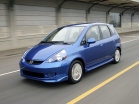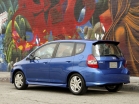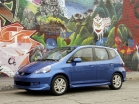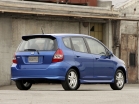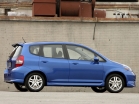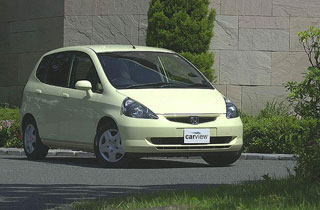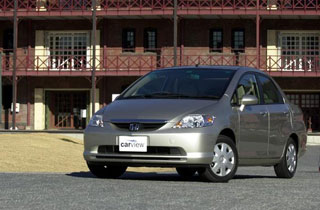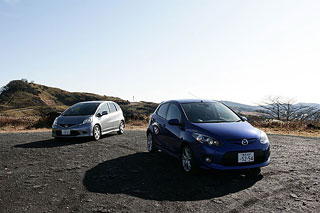Honda Fit 2006 test drive - 2008
Comparison of stylish cars of the compact class: Toyota Belta, Honda Fit Aria, Mitsubishi "I"
It is generally accepted that the Toyota Belta compact sedan is replaced by the Toyota Platz model, which, as you know, was a derivative of the Toyota Vitz hatchback sedan. It is also believed that it is mainly focused on female drivers. According to the generally accepted classification, the Belta model occupies the last line of the classification table of sedans. But he should have his own competitors. Who are they?But first, a few words about the Toyota Belta car itself, which is equipped with a 1.3 working volume engine. liter, and the price of which ranges from 1 million 386 thousand to 1 million 753.5 thousand yen.
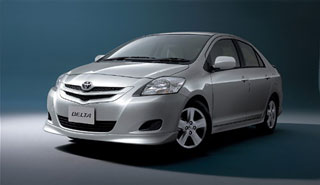 The follower looks wonderful.
The follower looks wonderful. What is the Toyota Belta car? This is a completely new model in the class of the smallest sedan, a three -Box (3 Box Car), which replaced the Toyota Platz car. Recently, for Toyota, it has become almost a tradition to remove a particular model that has a long story from production, to then release a car similar in terms of concept, but only under a completely new name. Wouldn't it be assumed that this time it seemed to someone that the name Platz is too much gives old (although if you count, what are its years?). By the way, there is an opinion that the Platz car was never an independent unit, that he is only a kind of a all of the same hatchback toyota vitz. To make sure of this, it is enough, they say, to compare the stamping of both bodies. It’s just that a trunk was attached to him from behind, so a semblance of a sedan came out. But if you compare to the end, then let's take the new Belta sedan and put next to the Ractis car with the same wheelbase. And what will we see. And the fact that the new Belta has no less, and maybe even more rights to be called a sedian variant of Ractis! So do not compare it with related models, it will clarify little. It is better to accept on faith that the Platz sedan used to be, now he was replaced by a Belta car and try to determine what their differences are. So, if you look at the previous Platz model on the side, you will immediately pay attention to a certain imbalance of the body shape. AT
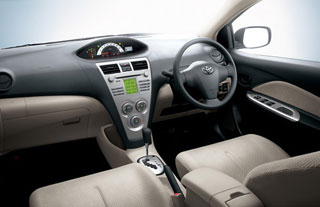 the counterweight to this Belta body is perceived more balanced. What is the matter? I believe that all because of the other location of the rear wheels. In fact, the wheelbase of the new car became larger, the rear wheels shifted back, and visually, as it were, they began to support the rear racks. Let's look at numerical indicators. The distance between the axes increased by 180 mm, and the length of the new car also became larger, but only 120 mm. So, the visible shift of the rear wheels back, which I am talking about, is precisely due to the presence of this very difference of 60 mm. Along the way, I note that the width of the car also increased by 30 mm and became 1690 mm. Thus, the body in its dimensions came close to the boundaries of the so-called 5th dimensional group. In short, if it is said that the new Belta machine looks better than its Platz predecessor, then this should be interpreted in such a way that the new body simply acquired more natural proportions. One of the two varieties of the engine can be installed on this body: either a four -cylinder with a working volume of 1.3 liters, or a three -cylinder, one -liter. As for the types of transmission, the modifications that have a FWD (Full Wheel Drive or otherwise all -wheel drive) drive system are equipped with a stray CVT variator. In turn, those machines that are driven through a 4WD all-wheel drive controlled by a liquid differential of increased friction are equipped with 4-speed automatic gearboxes with a hydraulic coupling. By the way, now
the counterweight to this Belta body is perceived more balanced. What is the matter? I believe that all because of the other location of the rear wheels. In fact, the wheelbase of the new car became larger, the rear wheels shifted back, and visually, as it were, they began to support the rear racks. Let's look at numerical indicators. The distance between the axes increased by 180 mm, and the length of the new car also became larger, but only 120 mm. So, the visible shift of the rear wheels back, which I am talking about, is precisely due to the presence of this very difference of 60 mm. Along the way, I note that the width of the car also increased by 30 mm and became 1690 mm. Thus, the body in its dimensions came close to the boundaries of the so-called 5th dimensional group. In short, if it is said that the new Belta machine looks better than its Platz predecessor, then this should be interpreted in such a way that the new body simply acquired more natural proportions. One of the two varieties of the engine can be installed on this body: either a four -cylinder with a working volume of 1.3 liters, or a three -cylinder, one -liter. As for the types of transmission, the modifications that have a FWD (Full Wheel Drive or otherwise all -wheel drive) drive system are equipped with a stray CVT variator. In turn, those machines that are driven through a 4WD all-wheel drive controlled by a liquid differential of increased friction are equipped with 4-speed automatic gearboxes with a hydraulic coupling. By the way, now 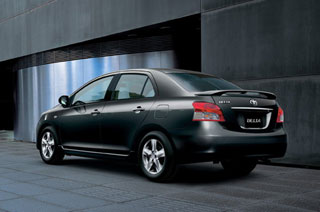 it is known that the Belta car will appear in the North American market over time, starting with the 2007 model, however, under a different name - Yaris Sedan. I believe that the adoption of such a decision was largely facilitated by the fact that the new (in relation to Platz sedan) has increased its dimensions, and is now considered quite competitive in America.
it is known that the Belta car will appear in the North American market over time, starting with the 2007 model, however, under a different name - Yaris Sedan. I believe that the adoption of such a decision was largely facilitated by the fact that the new (in relation to Platz sedan) has increased its dimensions, and is now considered quite competitive in America. Technical characteristics of the Belta 1.3 x S Package:
Length 4300 mm x width 1690 mm x height 1460 mm.
Wheel base: 2550 mm.
Machine weight: 1040 kg.
Drive: on the front wheels
Engine: 1-liter, 4-cylinder with an unlikely location of the cylinders, developed power 87 hp. at 6000 rpm, the largest torque is 11.8 kg/m at 4000 rpm.
Car price: 1 million 575 thousand yen.
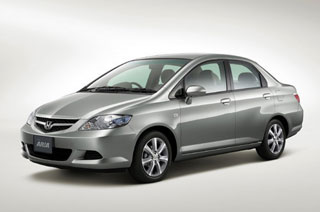 Competitor number 1 Honda Fit Aria. A car from the category of elites (by Asian standards).
Competitor number 1 Honda Fit Aria. A car from the category of elites (by Asian standards). A car called Honda Fit Aria first appeared on the market at the end of 2002. It was developed mainly in the calculation of the market of Southeast Asia, was fulfilled in a trioboblain body that is popular there, so that it can rightfully be called an Asian machine. By name, it is not difficult to guess that the base for this Asian was the same popular Honda Fit model. It began to be produced in Taiwan, so for the Japanese market it is a foreigner imported by import. In October 2005, the car experienced a complete replacement of its model range. Outwardly, this was expressed in some change in the design of the front and back of the body. If you take internal differences, the manufacturer decided to abandon the 1.3 liter engine, so now all Honda Fit Aria cars go only with a one and a half liter engine. For Honda, this is the smallest sedan, and for the inhabitants of the Asian countries, whose life is a life, you yourself know what kind of machine is perceived almost like an elite wheelbarrow. Still, in front of the car is decorated with a brilliant decorative grille of the radiator, inside the passenger compartment is visible details trimmed with wood. It is easy to guess why all this is needed - so that the FIT ARIA car becomes a cherished dream for the Asian.
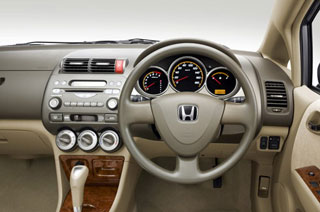 But let's compare this car with the Toyota Belta machine of the last sample. I immediately note that in length they noticeably differ from each other. In particular, the FIT ARIA length is greater than Belta, 90 mm. At the same time, compared with its basic Honda Fit model, it turns out that with the same wheelbase, the Fit Aria car, on the contrary, was made shorter by 100 mm. This could not but turn into some violation of the Honda Fit, familiar to the Honda Fit machines: it seems that the rear wheels are too much moved forward. However, this gave some positive results: the niches of the rear wheels became almost invisible inside the trunk, which is why its capacity only won. Now it is 500 liters, which is 25 liters more than the volume of the luggage of Belta.
But let's compare this car with the Toyota Belta machine of the last sample. I immediately note that in length they noticeably differ from each other. In particular, the FIT ARIA length is greater than Belta, 90 mm. At the same time, compared with its basic Honda Fit model, it turns out that with the same wheelbase, the Fit Aria car, on the contrary, was made shorter by 100 mm. This could not but turn into some violation of the Honda Fit, familiar to the Honda Fit machines: it seems that the rear wheels are too much moved forward. However, this gave some positive results: the niches of the rear wheels became almost invisible inside the trunk, which is why its capacity only won. Now it is 500 liters, which is 25 liters more than the volume of the luggage of Belta. Due to the fact that the engine of the Honda Fit Aria car has a large cubic membrane, and is paired with a unavailable variator, in the range of the most frequently selected speeds in everyday trips, it is slightly lower than that of the motor, which is on the Belta machine. From this, the car makes less noise. But on the other hand, in the cabin, fuel splashes in the gas tank. Is it really impossible to eliminate this inevitable phenomenon for all machines, where the fuel tank is placed right in the middle (Center Tank Layout). On a good, smooth road, the car shows a fairly decent level of comfort, but when the road becomes uneven, the suspension is clearly not enough for the length of the course. Brows of the body
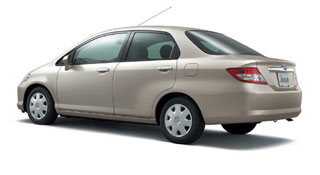 it is also too great that, as I understand it, it is due to the smaller wheelbase compared to the Toyota Belta car.
it is also too great that, as I understand it, it is due to the smaller wheelbase compared to the Toyota Belta car. Technical characteristics of the car Honda Fit Aria 1.5 W:
Length 4390 mm x width 1690 mm x height 1485 mm.
Wheel base: 2450 mm.
Machine weight: 1060 kg.
Drive: on the front wheels
Engine: 1.5 -4 -cylinder with in -line cylinders, developed power of 110 hp. at 5800 rpm, the largest torque is 14.6 kg/m at 4800 rpm.
Car price: 1 million 501.5 thousand yen.
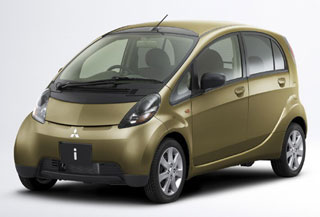 Competitor number 2 Mitsubishi I.
Competitor number 2 Mitsubishi I. Indeed, the machine is endowed with a number of functions that have an important applied value. But on the other hand, such an important component of any minivan as the comfort of the salon is not forgotten. The suspension of the new Serena car was decided not to make it smooth, rather soft. However, you need to take into account the considerable weight of the machine, plus the design of the chassis itself is quite stiff. So the softness of the suspension is combined with a large weight and hardness of the body, and this makes the machine less prone to swing. So, you sit in the front chair, and you feel comfortable, transplanted in the very ass of the cabin there even better! But most of all, of course, the comfort of the chairs located in the middle of the cabin, that is, in the second row, amazes. It seems that they have worked very thoroughly on them.
As already mentioned, the weight of the machine cannot be called small as many as 1600 kg. How does a 2-liter engine installed on the car cope with it? Well, let's start with the fact that this is the only option for the motor that are equipped with all categories of the new machine. Secondly, he develops power up to 137 hp, which in itself seems to be not much. And, nevertheless, if 4 adults are in the cabin, the engine copes with its work without any problems, whether it is a city street, or a high -speed highway. This is a common merit as the engine itself, which demonstrates improved speed characteristics just in that speed range, which is most often in demand, and successfully fitted, unhappy transmission CVT. At the very first moment of acceleration, the thrust is such that the driver’s back simply presses into the back of the seat, but then everything flows smoothly, without tangible power changes. At the same time, when moving at high speed in the cabin, it really becomes noisy. How to not thank the authors of the project, which prudently provided the salon with an internal negotiation device!
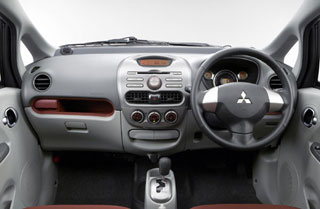 Competitor number 2 Mitsubishi I. The disadvantages of a too small car.
Competitor number 2 Mitsubishi I. The disadvantages of a too small car. The debut of this model took place. Well, still, unprecedented, as terrible as possible in the length of the body, which was dubbed as the SHORT LOOK body, the rear -length engine developed in the Mitsubishi company itself (such a location scheme is indicated by the abbreviation RM Rear Midship). Plus, the gas tank, located in the middle of the machine, (layout developed by Honda and borrowed by patent). As for the engine itself, it is notable for the fact that Mitsubishi has never made micro -litrae motors entirely from aluminum alloy before. All these factors, according to the organizers of the advertising company, had to beat one point, convincing the customers that difficult times for Mitsubishi behind and that only heyday and rise are ahead. True, the price of a new car aroused some embarrassment among the public. Still, the price scatter was such that the upper bar came too high. Is it a joke to say that the price of a micro -lighting machine was set at a level of 1 million 281 thousand to 1 million 617 thousand yen. That is, it could surpass the cost of the Toyota Belta car, which belongs to the class not of micro -littration, but already small -scale machines, that is, it costs a step higher. However, the authors of the project seemed to be not at all embarrassed, and they gave vigorous explanations in that way that, they say, the car required special delicacy in manufacture, the costs were the same as there were no ordinary micro -lines in the production of, so the buyer should enter into a position and believe that it was impossible otherwise.
The interior of this shorty should also, according to designers, change the general idea of \u200b\u200bhow the salon of a micro -litter machine should look. The arrangement of the Toyota Belta salon is not devoid of certain elegance, for example, seating with a two -ton upholstery. But in the Mitsubishi I salon, a completely different environment, exquisite and sophisticated, with which the Belta interior can hardly be compared. But at the same time, the highly lifted price bar and quality hit the developers with the reverse end. The buyer has a moral right to be meticulous. And then it turned out that there are a number of shortcomings, or, more precisely, shortfall. For example, at present, in almost any small -scale car, the height of the upper bracket under the seat belt is adjustable in height. And in the salon Mitsubishi I is not. Further, the rear -view mirror, as a rule, has a protective device from blinding with bright light, but this useful thing in the salon I is also not provided. Yes, and the steering column - because its slope is not regulated! Well, I can agree with the opinion that the success or failure of this car will not be determined by its cost. Well, why was it skimp on and save the extra ten thousand yen? Wasn’t it better to finish the work that has begun and equip the machine so that it was in no way inferior to an ordinary car of a small-leaf-class?
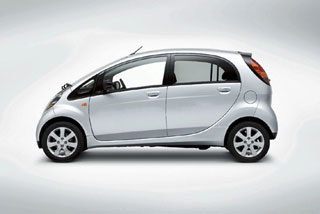 The rear and front wheels protrude if you look at the car from the side, a kind of audience limiters of the body length. Such a wide, almost the entire length of the body, the arrangement of the wheels allowed, despite the fact that the car is called a shorty, provide it with a wheelbase of 2550 mm, that is, the same as that of the small -leaved Sedan Belta. As for the width, here the micro -litage is connected by certain restrictions, and therefore its value of 1475 mm did not reach the full width of the Belta car, although it is comparable with the width of its track. It should be recalled that the perfect option in terms of stability, when the distance between the stains of the tire contact from the road from the car has the same, which is in length, which is wide. But here it is necessary to choose what is more important, an elongated wheelbase, or the ratio of the width of the track and the distance between the axes.
The rear and front wheels protrude if you look at the car from the side, a kind of audience limiters of the body length. Such a wide, almost the entire length of the body, the arrangement of the wheels allowed, despite the fact that the car is called a shorty, provide it with a wheelbase of 2550 mm, that is, the same as that of the small -leaved Sedan Belta. As for the width, here the micro -litage is connected by certain restrictions, and therefore its value of 1475 mm did not reach the full width of the Belta car, although it is comparable with the width of its track. It should be recalled that the perfect option in terms of stability, when the distance between the stains of the tire contact from the road from the car has the same, which is in length, which is wide. But here it is necessary to choose what is more important, an elongated wheelbase, or the ratio of the width of the track and the distance between the axes. To the honor of engineers participating in the project, I must say that on the go, the Mitsubishi I car behaves very well. In particular, the suspension, which gently but reliably holds the body in a horizontal plane, makes even a better impression than in the Belta sedan. But when the fluctuations reach their climax, the suspension simply tightly slows down the body to provide the machine with maximum stability. But the steering always acts accurately and clearly beyond any expectations. By the way, if I have touched on the question of handling, I must notice that the highest level is reached in the Mitsubishi I car, which has a 4WD drive. Although, on the other hand, to opt for such a modification, it means that it is even more painful to hit your pocket.
Technical characteristics of Mitsubishi I G:
Length 3395 mm x width 1475 mm x height 1600 mm.
Wheel base: 2550 mm.
Machine weight: 900 kg.
Drive: on the rear wheels from the engine located above the rear bridge
Engine: working volume 660 cubic meters. See, 3-cylinder with a in-line location of cylinders, developed power of 64 hp. at 6000 rpm, the largest torque is 9.6 kg/m at 3000 rpm.
Car price: 1 million 491 thousand yen.
A source: Webcg.net

